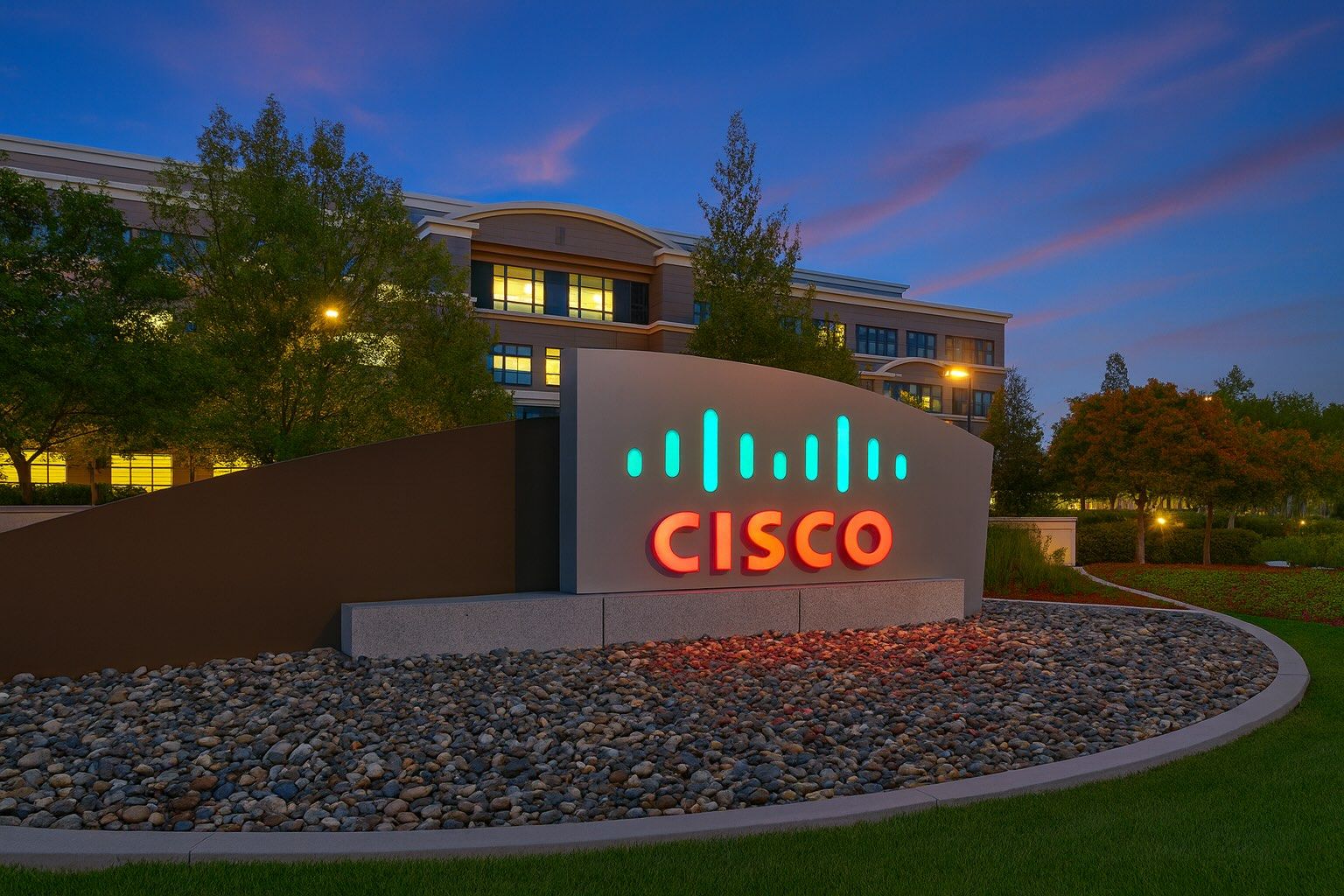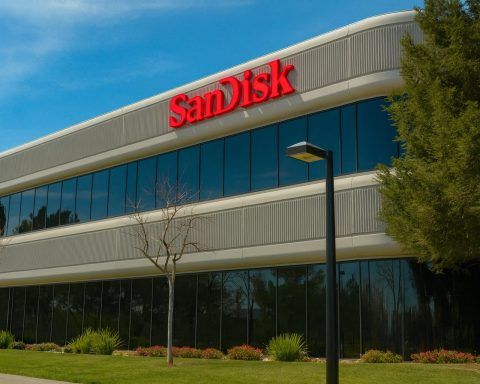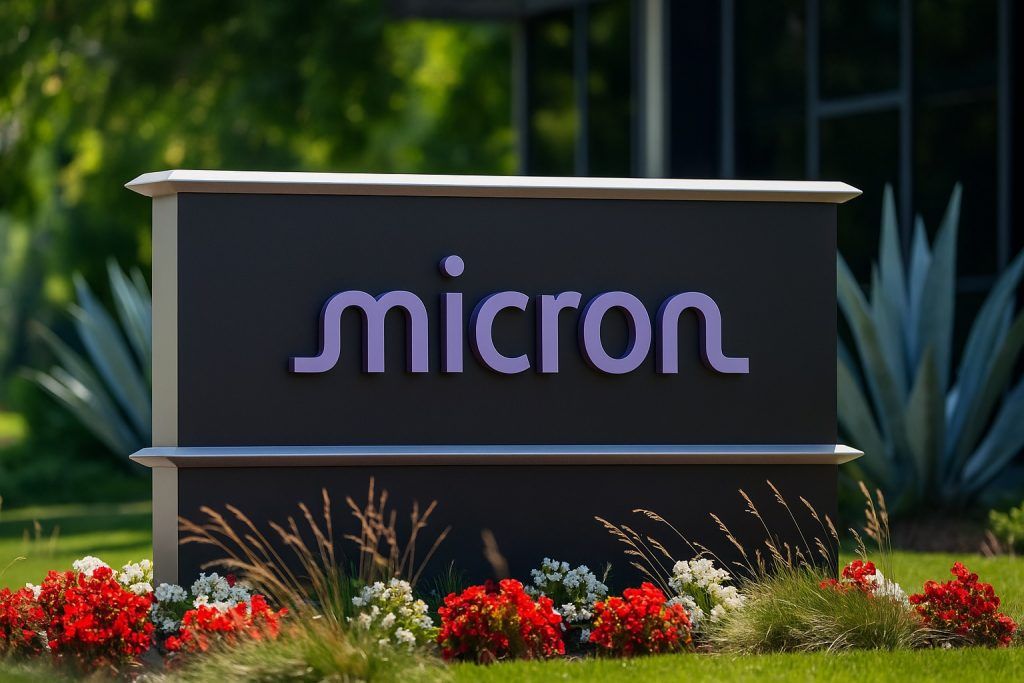Snapshot: How Cisco Stock Looks This Morning
Cisco Systems (NASDAQ: CSCO) is starting Thursday, November 20, 2025, right on the edge of record territory as Wall Street digests a wave of AI‑related announcements, a new quantum computing alliance with IBM, and a major security overhaul of its networking portfolio.
- Last close (Nov 19, 2025): $78.39, up 1.32% on the day [1]
- Pre‑market indication (Nov 20, ~06:00): around $78.98, up ~0.75% vs. yesterday’s close [2]
- 52‑week range: $52.11 – $79.50, putting Cisco just below its recent 52‑week and 20‑year high [3]
- 12‑month performance: roughly high‑30s % gain, with some services estimating ~36–40% total return over the past year [4]
- Valuation: market cap a little above $300 billion and a trailing P/E in the high‑20s, according to recent broker and brokerage snapshots [5]
Against that backdrop, today’s Cisco stock story is dominated by three fresh themes:
- A new AI infrastructure joint venture with AMD and Saudi startup Humain gaining more analyst attention. [6]
- A just‑announced quantum networking collaboration with IBM aimed at building a future “quantum computing internet.” [7]
- A security initiative called “Resilient Infrastructure”, which tightens default configurations across Cisco’s networking portfolio. [8]
Cisco Stock Price Today: Still Riding the Post‑Earnings AI Wave
Cisco’s post‑earnings rally from last week is still the main driver of today’s elevated share price.
- Cisco closed Wednesday, November 19 at $78.39, with a daily range between $77.16 and $78.93. [9]
- Pre‑market trading this morning suggests a slightly higher open around $79, keeping the stock within touching distance of its $79.50 52‑week high, set after its earnings beat and guidance hike. [10]
Over the last month, the stock has broken out from the low‑70s into the high‑70s, helped by:
- A strong fiscal Q1 2026 earnings report, with revenue up about 8% year‑on‑year to $14.88 billion and GAAP net income of $2.86 billion. [11]
- A guidance raise: Cisco now projects fiscal 2026 revenue of $60.2–$61.0 billion (previously $59–$60 billion) and adjusted EPS of $4.08–$4.14 (up from $4.00–$4.06), explicitly citing AI networking demand. [12]
In other words, today’s price action is less about a single headline spike and more about the market continuing to price in Cisco as a major infrastructure winner in the AI build‑out.
AI Mega‑Theme, Part 1: The AMD–Cisco–Humain Data Center Joint Venture
One of the biggest storylines feeding into Cisco’s AI narrative this week is the joint venture with Advanced Micro Devices (AMD) and Saudi AI company Humain.
What the JV is building
According to a Reuters report, AMD, Cisco and Humain are forming a yet‑to‑be‑named joint venture to build AI data centers across the Middle East, starting with a 100‑megawatt facility in Saudi Arabia. [13]
Key details:
- The first project is a 100 MW AI data center in Saudi Arabia, and
- Generative video startup Luma AI has already contracted to buy the entire 100 MW of computing capacity, making it the JV’s first publicly named customer. [14]
- The JV plans to scale to up to 1 gigawatt of AI data center capacity by 2030, targeting markets across Asia, Europe, India, the Middle East and Africa—a region representing roughly 4.5 billion people. [15]
- Cisco’s role is to supply networking gear and other infrastructure and to leverage its global salesforce to help sell capacity in these data centers; AMD will provide its advanced MI450 AI accelerators. [16]
Why it matters for CSCO stock
From a numbers standpoint, Evercore ISI estimates the JV could be worth $300–$500 million in revenue for Cisco in 2026 based on the initial 100 MW deployment. That would translate to:
- More than 0.5% additional revenue growth, and
- $0.02–$0.04 in incremental EPS, if things ramp as planned. [17]
Longer term, if the JV scales to 1 GW by 2030, Evercore thinks it could represent $3–$5 billion in cumulative revenue for Cisco over a five‑year period. [18]
For investors, the JV reinforces two points:
- Cisco is not just selling AI‑ready switches and routers; it wants a slice of the economics of entire AI infrastructure stacks.
- The company is positioning itself in sovereign and regional AI build‑outs, especially where energy and land are abundant—like Saudi Arabia—which could help diversify away from the U.S. hyperscalers over time.
The flip side: these projects are multi‑year, capex‑heavy and politically sensitive, so revenue may be lumpy and tied to broader AI investment cycles.
AI Mega‑Theme, Part 2: Evercore, JPMorgan and Others Re‑Rate Cisco
Today’s Evercore note sits on top of a broader wave of bullish analyst revisions following last week’s earnings.
From recent research roundups: [19]
- Evercore ISI
- Rating: In Line
- Price target: $80
- Adds the HUMAIN JV upside scenario (up to $3–$5B over time) to the AI thesis.
- J.P. Morgan
- Maintains “Overweight” and recently lifted its price target to $90.
- BofA Securities
- Rating: Buy
- Price target raised from $85 to $95.
- Rosenblatt Securities & Melius Research
- Both reportedly pushed targets to $100, citing strong AI networking demand despite a softer security segment.
- UBS and Piper Sandler
- Targets in the mid‑$80s to $90, generally bullish on AI infrastructure momentum.
Aggregators like TipRanks show that, as of today, Cisco carries a “Moderate Buy” consensus with an average target price around $88–$89, implying mid‑teens upside from current levels. [20]
All of this frames today’s trading: CSCO is no longer a deep value turnaround; it’s being priced more like a steady, AI‑leveraged infrastructure blue chip.
Quantum Computing Alliance with IBM: Cisco Aims Beyond Classical Networking
Today’s second big strategic announcement is Cisco’s quantum computing collaboration with IBM, unveiled in a joint press release dated November 20, 2025. [21]
What IBM and Cisco are planning
The two companies plan to:
- Design a networked architecture for large‑scale, fault‑tolerant quantum computers, with an initial proof‑of‑concept demonstration of multiple networked quantum systems within about five years (targeting around 2030). [22]
- Work toward a “distributed quantum computing” network, in which multiple quantum processors in different cryogenic environments are linked via advanced quantum networking hardware. [23]
- Lay the groundwork for a possible “quantum computing internet” in the late 2030s, connecting quantum computers, sensors and communication systems across data centers and metro‑scale networks. [24]
IBM brings the quantum processors and roadmap, while Cisco contributes:
- A quantum networking unit (QNU) concept to bridge quantum processors to the network, and
- An envisioned quantum data center architecture that preserves fragile quantum states and dynamically routes entanglement between nodes. [25]
Why investors care (even though it’s long‑dated)
In practical terms, this is not a near‑term earnings driver. But it signals:
- Cisco’s ambition to remain the default fabric for whatever “compute” looks like next, whether AI clusters or quantum supercomputers.
- A defensive moat: customers that standardize on Cisco for AI networking today are more likely to extend that relationship into next‑generation compute fabrics tomorrow.
For a stock already valued as a long‑duration infrastructure play, announcements like this help support the “durability of growth” narrative, even if quantum revenue is years away.
Security Push: Cisco’s New “Resilient Infrastructure” Initiative
Alongside the hardware and AI buzz, Cisco also used November 20 to push a very different—but highly relevant—message: network security debt is out of control, and Cisco intends to reset the defaults.
In a blog post titled “Doubling down on resilient infrastructure,” Cisco’s Chief Security & Trust Officer Anthony Grieco laid out a multi‑stage plan: [26]
- A Cisco‑commissioned report found that 48% of network assets worldwide are aging or obsolete, diverting budgets to maintenance and increasing cyber risk. [27]
- Cisco wants secure configurations, protocols and features to be the default across its portfolio, making it obvious when customers choose weaker settings.
- Over time, Cisco plans to:
- Increase security warnings for insecure features,
- Then disable them by default, and
- Ultimately remove certain legacy insecure options altogether. [28]
- The company also highlights work on “targeted real‑time shields”—protections that can be deployed quickly to mitigate new vulnerabilities without waiting for disruptive patch cycles. [29]
For investors, the takeaway is twofold:
- Better defaults and automation could strengthen Cisco’s value proposition for large, risk‑sensitive customers—especially governments, critical infrastructure and financial institutions.
- Security has been one of Cisco’s slower‑growing segments recently; this initiative could be part of an effort to re‑accelerate growth and defend share against specialist security vendors.
Growth Story in India: “Phenomenal Opportunity” in AI‑Driven Manufacturing
Another fresh data point today comes from The Economic Times, where Cisco executives described a “phenomenal opportunity” in India, especially around AI at the edge. [30]
Highlights from the interview:
- Raymond Janse van Rensburg, a senior Cisco networking executive in APJC, says India’s manufacturing sector is emerging as a key AI use case, with companies wanting to run inference on the factory floor for latency and intellectual‑property reasons. [31]
- He notes strong traction not only in manufacturing, but also in financial services, transportation, airports, and small and mid‑sized businesses. [32]
- Simon Miceli, Cisco’s APJC AI infrastructure lead, points to structural constraints—capital, power and GPU supply—as limiting factors, along with trust and security concerns around AI. [33]
For CSCO, India fits into the broader picture:
- It supports Cisco’s regional diversification beyond U.S. and European enterprises.
- It aligns well with Cisco’s emphasis on AI‑ready networking at the edge, where data and compute need to stay on‑premises due to latency or regulatory requirements.
While not an immediate catalyst like the HUMAIN JV, this kind of commentary helps justify Cisco’s mid‑single‑digit revenue growth outlook baked into current forecasts. [34]
Earnings Context: AI Networking Is Now the Core of the Bull Case
All of today’s headlines sit on top of a very AI‑centric quarter that Cisco reported last week:
- Fiscal Q1 2026 revenue: $14.88 billion, up 8% year‑over‑year. [35]
- Product revenue: up about 10%, led by networking, which grew roughly 15%; security and collaboration were slightly down year‑on‑year. [36]
- Cisco recorded $1.3 billion in AI infrastructure orders from hyperscalers during the quarter, about 50% higher than the prior quarter, and says its AI order pipeline is now in excess of $2 billion. [37]
- CEO Chuck Robbins expects $3 billion in AI infrastructure revenue from hyperscalers in fiscal 2026, up from previously disclosed figures. [38]
That combination of:
- Solid double‑digit growth in core networking,
- A visible, multi‑billion‑dollar AI order pipeline, and
- A willingness to raise multi‑year guidance,
is exactly why CSCO has finally broken through levels it last saw during the dot‑com bubble.
But not everyone is convinced this can go on forever. A recent piece in Business Insider points out that it took Cisco more than 25 years to reclaim its dot‑com‑era stock price, using that as a cautionary example for today’s AI‑driven rallies. [39]
What Today’s News Means for Cisco Investors
Putting the November 20 headlines together:
Bullish factors
- AI infrastructure flywheel: The HUMAIN JV, analyst upgrades, and hyperscaler orders all support the idea that Cisco is emerging as a core fabric for AI data centers, not just an old‑school router vendor. [40]
- Optionality in quantum and security: The IBM deal and the Resilient Infrastructure initiative give Cisco long‑dated growth and differentiation stories in both quantum networking and hardened infrastructure. [41]
- Geographic and vertical diversification: Commentary from India underscores that growth isn’t only about U.S. hyperscalers; manufacturing, finance and transit in emerging markets are also part of the opportunity. [42]
Things to watch and key risks
- Valuation creep: With the stock near a 20‑year high and trading at roughly high‑20s earnings multiples, future returns depend on Cisco executing on mid‑to‑high single‑digit growth and sustained AI demand. [43]
- Cyclicality in AI capex: The HUMAIN JV and hyperscaler projects involve massive capital cycles. Any slowdown in AI spending—or delays in large data center projects—could pressure growth expectations. [44]
- Security and legacy product drag: Cisco’s own blog highlights how much of the world’s infrastructure is old and vulnerable. Moving customers to more secure, modern platforms is good long term but can create short‑term cost and complexity, and security revenue has been softer than networking. [45]
- Quantum timelines: The IBM partnership is strategically important but unlikely to generate material revenue for years, making it more of an option than a near‑term cash driver. [46]
Bottom Line for November 20, 2025
Today’s news flow reinforces the idea that Cisco stock is now an AI and infrastructure play first, and a traditional networking stock second.
With:
- Shares hovering just below all‑time highs,
- A rising chorus of analysts hiking price targets, and
- New initiatives spanning AI data centers, quantum networking and security,
investors are effectively betting that Cisco can avoid repeating its dot‑com history and instead translate this cycle of technology hype into sustained, compounding earnings growth.
As always, this overview is for information only and not investment advice. Anyone considering CSCO should weigh today’s optimistic AI narrative against the usual risks: hardware cycles, macro slowdowns, and the possibility that AI infrastructure spending normalizes faster than the market currently expects.
References
1. www.investing.com, 2. www.investing.com, 3. www.investing.com, 4. www.investing.com, 5. www.marketwatch.com, 6. www.investing.com, 7. newsroom.cisco.com, 8. blogs.cisco.com, 9. www.investing.com, 10. www.investing.com, 11. investor.cisco.com, 12. www.reuters.com, 13. www.investing.com, 14. www.investing.com, 15. www.investing.com, 16. www.investing.com, 17. ca.investing.com, 18. ca.investing.com, 19. www.investing.com, 20. www.tipranks.com, 21. newsroom.cisco.com, 22. newsroom.cisco.com, 23. newsroom.cisco.com, 24. newsroom.cisco.com, 25. newsroom.cisco.com, 26. blogs.cisco.com, 27. blogs.cisco.com, 28. blogs.cisco.com, 29. blogs.cisco.com, 30. m.economictimes.com, 31. m.economictimes.com, 32. m.economictimes.com, 33. m.economictimes.com, 34. investor.cisco.com, 35. investor.cisco.com, 36. investor.cisco.com, 37. www.reuters.com, 38. www.reuters.com, 39. www.businessinsider.com, 40. www.investing.com, 41. newsroom.cisco.com, 42. m.economictimes.com, 43. www.barchart.com, 44. www.investing.com, 45. blogs.cisco.com, 46. newsroom.cisco.com







